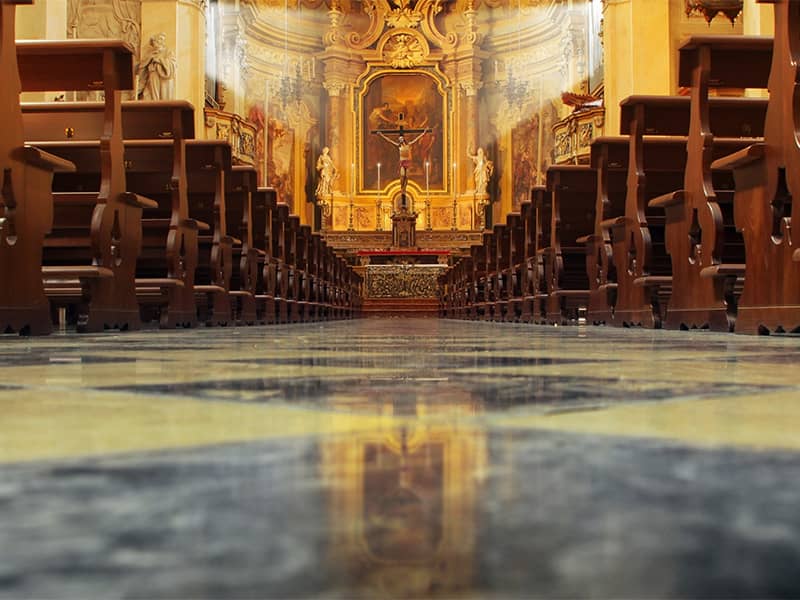The 80-year-old pontiff will place a biretta, a square red cap denoting the rank of cardinal, on the head of each man Wednesday during a four-hour Consistory and Mass in St. Peter's Square. On Thursday, the church Feast of the Chair of St. Peter, the pope will concelebrate Mass with the new cardinals in St. Peter's Basilica and give each a cardinal's ring.
The ceremonies are important to the future of the Roman Catholic Church because it is members of the College of Cardinals who elect the pope, and Canon (church) Law requires the cardinals to chose the pope from their own numbers.
The Consistory is the eighth formal meeting of cardinals that John Paul has called to create new princes of the church during the 22 years of his pontificate. It will raise membership in the College of Cardinals to 184.
Of the 135 cardinals under the age of 80 and thus eligible to vote in the Conclave that will elect the next pope, 125 were chosen by John Paul, 10 by Pope Paul VI.
But this does not mean that the next leader of the world's 1 billion Catholics automatically will be a priest in the image of the doctrinally conservative, Polish-born prelate, who was himself a surprise choice.
Vatican observers believe an overriding concern of the cardinals who serve as residential bishops of sees throughout the world and are a majority in the College of Cardinals is to curtail the growing power of the Roman Curia, the church's central administrative body, over diocesan affairs.
Because John Paul's papacy is among the longest in church history, it also is possible that the cardinals will want the next pope to be an older prelate to ensure a shorter reign. They recall that following the 20-year papacy of Pius XII, the cardinals elected John XXIII, who was 77 at the time and reigned for little more than five years.
John Paul, elected at the age of 58, was the youngest and longest-serving pope chosen in the 20th century. At the age of 80, he suffers the debilitating effects of a neurological disease but has maintained a demanding schedule.
The pope had been expected to announce a Consistory shortly after the Jubilee Holy Year 2000 ended on Jan. 6, but both the way he made the announcement and the large number of new cardinals came as a surprise. Speaking from his study balcony overlooking St. Peter's Square during the Sunday Angelus prayer on Jan. 21, John Paul disclosed the names of 37 new cardinals. Then, in what is believed to be a move unprecedented in church history, he added seven more names the next Sunday, Jan. 28.
The pope far exceeded Paul VI's limit of 120 cardinals of voting age by nominating 40 new cardinals under the age of 80. The total of 44 new cardinals is believed to be a record.
Of the new cardinals, 23 came from Europe, three from North America, 11 from Latin America, two from Africa, three from Asia and two from the Middle East. They include seven Italians, the largest national group, and five from the former Soviet bloc countries of Ukraine, Latvia, Lithuania and Poland.
The pope had chosen two of the Eastern Europeans -- Ukrainian Latin Rite Archbishop Marian Jaworski, 74, of Lviv and Latvian Archbishop Janis Pujats of Riga, 70 -- for his last Consistory in 1998 but kept their names "in pectore" (in the heart) without disclosing them for fear of endangering their ministries. They will enter the College of Cardinals with the seniority of 1998 members.
The new U.S. cardinals are Archbishops Edward M. Egan, 68, of New York and Theodore E. McCarrick, 70, of Washington and the Rev. Avery Dulles, 82, an eminent Jesuit theologian, who held the McGinley Chair at Fordham University in New York.
Both Egan and McCarrick were only recently appointed to their sees. Egan, installed June 19, had served previously as a judge of the Sacred Roman Rota and bishop of Bridgeport, Conn., and McCarrick, installed Jan. 4, was bishop of Newark, N.J.
Dulles is the son of John Foster Dulles, secretary of state in the Eisenhower administration and nephew of Allen Dulles, who was head of the Central Intelligence Agency. Born into a Presbyterian family, Avery Dulles became a Roman Catholic while attending Harvard College in the early 1940s.
Archbishop Cormac Murphy-O'Connor, of Westminster in London, another new appointee who will become a cardinal, will introduce an ecumenical element into the Consistory. He will bring to the ceremony as his guests two ranking Anglicans, Canon Richard Marsh, ecumenical secretary to Archbishop of Canterbury George Carey, and Bishop Mark Santer of Birmingham.
Murphy-O'Connor and Santer served together until recently as co-chairman of the Anglican-Roman Catholic International Commission for dialogue between the two churches.
Other new cardinals include the archbishops of Abidjan, Ivory Coast; Durban, South Africa; Bombay and Ernakulam-Angamaly of the Syro-Malabars, India; Quito, Ecuador; Sao Paulo and Sao Salvador da Bahia, Brazil; Bogota, Colombia; Santiago, Chile; Tegucigalpa, Honduras; Caracas, Venezuela; Buenos Aires, Argentina; Santa Cruz de la Sierra, Bolivia; Dublin, Ireland; Vilnius, Lithuania; Lyon, France; Toledo, Spain; Lisbon, Portugal; Turin, Italy; Lviv, Ukraine; and Paderborn and Mainz, Germany.

